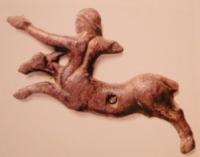You are here
Chilburj fortress.

Individual phototours over Turkmenistan.
«Genhis Khan’s youngest son Toloi arrived at the head of an army in January 1221, and spent six days preparing to besiege the city with terrifying catapults and bettering rams. This was merely a phase of psychological tenderizing – and it worked»
Trip from Ashgabad to Mary.
Chilburj is an ancient fortress 20 km to the north-west of Merv. Its historic name is not established. The fortress represents an irregular rectangle in plan (230 х 260 x 200 m). Its walls are thickly flanked with protruded rectangular goffered towers.
The fortress corners are strengthened with powerful bastions. Sections between towers have in-wall passageways with the niches for archers. Towers and inter-tower ways are densely covered with arrow-shaped loopholes, mostly false.
Chilburj had two gates (northern and southern ones) through which the central street crossed the town. Initially this was a military fortress therefore its yard was not built up; just in the centre a trace of some construction survived where the fire was kept on.
The fortress was founded in the Late Parthian time (II - III c.c.A.D.). In the Late Sasanian period (V - VII c.c.), Chilburj was a flourishing town with the dense building of shakhristan and rabad; its development was broken off by the Arabian invasion.
The third stage of the town life refers to the period of the developed Middle Ages (X - XII c.c.) when it was used for caravans' halting place; in the X c. a small juma-mosque (34 x 32 m) was built nearby. As a caravanserai Chilburj existed up to the Mongol invasion whereupon it was abandoned completely.
Historical name of the town is not established. For the first time Chilburj was registered by the American mission (R.Pumpelly) at the beginning of the XX century but just after the investigations of the Southern Turkmen Archaeological Complex Expedition (YuTake) in the late 1940's - early 1950's it became widely known.
In the 1980's the joint Turkmen-Russian archaeological expedition (A.G.Gubaev and G.A.Koshelenko) carried out here excavations. Information acquired in the process of these works allowed to conceive the history of this monument more exactly.
The Late Parthian fortress Chilburj continues traditions of the Early Parthian period which are fully reflected in the fortress of Durnaly (I - II c.c. A.D.). Keeping traditional for the Parthian architecture the wall type with numerous towers of rectangular form cut through with embrasures (like in Durnaly).
The principle of gate fortification typical for the Middle Asian antiquity, Chilburj provides the earliest in Middle Asia example of using the wall goffering usual for the VII - X cc. architecture.
Authority:
http://whc.unesco.org







